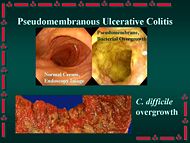Pseudomembranous enterocolitis
| Pseudomembranous enterocolitis | |
|---|---|
| Pseudomembranous enterocolitis | |
| MeSH | D004761 |
In medicine, pseudomembranous enterocolitis is an "acute inflammation of the intestinal mucosa that is characterized by the presence of pseudomembranes or plaques in the small intestine (pseudomembranous enteritis) and the large intestine (pseudomembranous colitis). It is commonly associated with antibiotic therapy and clostridium difficile colonization."[1]
Diagnosis
The accuracy of laboratory tests is:[2]
| Sensitivity | Specificity | |
|---|---|---|
| Cytotoxin by enzyme immunoassay | 73% | 97% |
| Cell culture cytotoxin assay (tissue culture assay) |
77% | 97% |
| Real-time polymerase chain reaction for toxin B gene |
93% | 97% |
| Anaerobic culture (for toxigenic C. difficile strains) |
100% | 96% |
Treatment
Antibiotics
Various antibiotics have been studied in randomized controlled trials.[3][4][5] Teicoplanin may be the most effective antibiotic.[3][4] Vancomycin has an insignificant trend towards being better than metronidazole.[3]
Administration of bacteria
Probiotic administration may[6] or may not [7]help according to a meta-analyses and a more recent randomized controlled trial.[8] However, probiotics can be harmful among intensive care patients.[9]
Recurrent infection
A clinical prediction rule found that recurrent infection is more likely if age is more than 65 years, the patient has severe or fulminant illness, and additional antibiotic exposure occurs after after treatment of the initial Clostridium difficile infection.[10] Use of antacids may also be a risk factor for recurrence.[11]
Asymptomatic carriage should not be treated according to a meta-analysis.[12]
Antibiotics
Observational cohort studies conflict regarding the best agent and suggest vancomycin may[13] or may not[14] be better than metronidazole. Various methods exist for the administration of vancomycin[13][15]
Serial therapy with vancomycin and rifaximin has been studied in a small uncontrolled series of patients.[16]
Administration of bacteria
Probiotics may help.[17] However, probiotics can be harmful among intensive care patients.[9]
Rectal infusion of feces helped according to case reports.[18][19]
References
- ↑ Anonymous (2025), Pseudomembranous enterocolitis (English). Medical Subject Headings. U.S. National Library of Medicine.
- ↑ 2.0 2.1 Peterson LR, Manson RU, Paule SM, et al (November 2007). "Detection of toxigenic Clostridium difficile in stool samples by real-time polymerase chain reaction for the diagnosis of C. difficile-associated diarrhea". Clin. Infect. Dis. 45 (9): 1152–60. DOI:10.1086/522185. PMID 17918076. Research Blogging.
- ↑ 3.0 3.1 3.2 Nelson R (2007). "Antibiotic treatment for Clostridium difficile-associated diarrhea in adults". Cochrane Database Syst Rev (3): CD004610. DOI:10.1002/14651858.CD004610.pub3. PMID 17636768. Research Blogging.
- ↑ 4.0 4.1 Wenisch C, Parschalk B, Hasenhündl M, Hirschl AM, Graninger W (May 1996). "Comparison of vancomycin, teicoplanin, metronidazole, and fusidic acid for the treatment of Clostridium difficile-associated diarrhea". Clin. Infect. Dis. 22 (5): 813–8. PMID 8722937. [e]
- ↑ Musher DM, Logan N, Bressler AM, Johnson DP, Rossignol JF (January 2009). "Nitazoxanide versus Vancomycin in Clostridium difficile Infection: A Randomized, Double-Blind Study". Clin. Infect. Dis.. DOI:10.1086/596552. PMID 19133801. Research Blogging.
- ↑ McFarland LV (April 2006). "Meta-analysis of probiotics for the prevention of antibiotic associated diarrhea and the treatment of Clostridium difficile disease". Am. J. Gastroenterol. 101 (4): 812–22. DOI:10.1111/j.1572-0241.2006.00465.x. PMID 16635227. Research Blogging.
- ↑ Pillai A, Nelson R (2008). "Probiotics for treatment of Clostridium difficile-associated colitis in adults". Cochrane Database Syst Rev (1): CD004611. DOI:10.1002/14651858.CD004611.pub2. PMID 18254055. Research Blogging.
- ↑ Klarin B, Wullt M, Palmquist I, Molin G, Larsson A, Jeppsson B (September 2008). "Lactobacillus plantarum 299v reduces colonisation of Clostridium difficile in critically ill patients treated with antibiotics". Acta Anaesthesiol Scand 52 (8): 1096–102. DOI:10.1111/j.1399-6576.2008.01748.x. PMID 18840110. Research Blogging.
- ↑ 9.0 9.1 Muñoz P, Bouza E, Cuenca-Estrella M, et al (June 2005). "Saccharomyces cerevisiae fungemia: an emerging infectious disease". Clin. Infect. Dis. 40 (11): 1625–34. DOI:10.1086/429916. PMID 15889360. Research Blogging.
- ↑ Hu MY, Katchar K, Kyne L, et al (December 2008). "Prospective Derivation and Validation of a Clinical Prediction Rule for Recurrent Clostridium difficile Infection". Gastroenterology. DOI:10.1053/j.gastro.2008.12.038. PMID 19162027. Research Blogging.
- ↑ Garey KW, Sethi S, Yadav Y, DuPont HL (December 2008). "Meta-analysis to assess risk factors for recurrent Clostridium difficile infection". J. Hosp. Infect. 70 (4): 298–304. DOI:10.1016/j.jhin.2008.08.012. PMID 18951661. Research Blogging.
- ↑ Shim JK, Johnson S, Samore MH, Bliss DZ, Gerding DN (February 1998). "Primary symptomless colonisation by Clostridium difficile and decreased risk of subsequent diarrhoea". Lancet 351 (9103): 633–6. DOI:10.1016/S0140-6736(97)08062-8. PMID 9500319. Research Blogging.
- ↑ 13.0 13.1 McFarland LV, Elmer GW, Surawicz CM (July 2002). "Breaking the cycle: treatment strategies for 163 cases of recurrent Clostridium difficile disease". Am. J. Gastroenterol. 97 (7): 1769–75. DOI:10.1016/S0002-9270(02)04195-3. PMID 12135033. Research Blogging.
- ↑ Pépin J, Routhier S, Gagnon S, Brazeau I (March 2006). "Management and outcomes of a first recurrence of Clostridium difficile-associated disease in Quebec, Canada". Clin. Infect. Dis. 42 (6): 758–64. DOI:10.1086/501126. PMID 16477549. Research Blogging.
- ↑ Tedesco FJ, Gordon D, Fortson WC (November 1985). "Approach to patients with multiple relapses of antibiotic-associated pseudomembranous colitis". Am. J. Gastroenterol. 80 (11): 867–8. PMID 4050760. [e]
- ↑ Johnson S, Schriever C, Galang M, Kelly CP, Gerding DN (March 2007). "Interruption of recurrent Clostridium difficile-associated diarrhea episodes by serial therapy with vancomycin and rifaximin". Clin. Infect. Dis. 44 (6): 846–8. DOI:10.1086/511870. PMID 17304459. Research Blogging.
- ↑ Surawicz CM (July 2008). "Role of probiotics in antibiotic-associated diarrhea, Clostridium difficile-associated diarrhea, and recurrent Clostridium difficile-associated diarrhea". J. Clin. Gastroenterol. 42 Suppl 2: S64–70. DOI:10.1097/MCG.0b013e3181646d09. PMID 18545161. Research Blogging.
- ↑ Schwan A, Sjölin S, Trottestam U, Aronsson B (October 1983). "Relapsing clostridium difficile enterocolitis cured by rectal infusion of homologous faeces". Lancet 2 (8354): 845. PMID 6137662. [e]
- ↑ Nieuwdorp M, van Nood E, Speelman P, et al (August 2008). "[Treatment of recurrent Clostridium difficile-associated diarrhoea with a suspension of donor faeces]" (in Dutch; Flemish). Ned Tijdschr Geneeskd 152 (35): 1927–32. PMID 18808083. [e]
